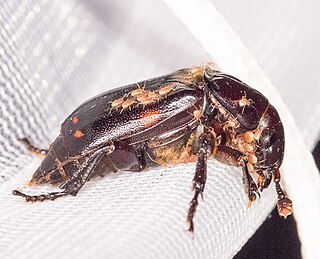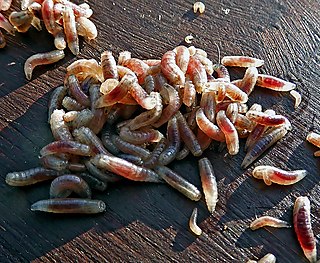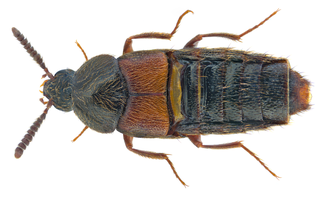
In evolutionary ecology, a parasitoid is an organism that lives in close association with its host at the host's expense, eventually resulting in the death of the host. Parasitoidism is one of six major evolutionary strategies within parasitism, distinguished by the fatal prognosis for the host, which makes the strategy close to predation.

The Tachinidae are a large and variable family of true flies within the insect order Diptera, with more than 8,200 known species and many more to be discovered. Over 1,300 species have been described in North America alone. Insects in this family commonly are called tachinid flies or simply tachinids. As far as is known, they all are protelean parasitoids, or occasionally parasites, of arthropods, usually other insects. The family is known from many habitats in all zoogeographical regions and is especially diverse in South America.

The rove beetles are a family (Staphylinidae) of beetles, primarily distinguished by their short elytra that typically leave more than half of their abdominal segments exposed. With over 66,000 species in thousands of genera, the group is the largest family in the beetle order, and one of the largest families of organisms. It is an ancient group, with fossilized rove beetles known from the Triassic, 200 million years ago, and possibly even earlier if the genus Leehermania proves to be a member of this family. They are an ecologically and morphologically diverse group of beetles, and commonly encountered in terrestrial ecosystems.

The Phoridae are a family of small, hump-backed flies resembling fruit flies. Phorid flies can often be identified by their escape habit of running rapidly across a surface rather than taking to the wing. This behaviour is a source of one of their alternate names, scuttle fly. Another vernacular name, coffin fly, refers to Conicera tibialis. About 4,000 species are known in 230 genera. The most well-known species is cosmopolitan Megaselia scalaris. At 0.4 mm in length, the world's smallest fly is the phorid Euryplatea nanaknihali.

Cleridae are a family of beetles of the superfamily Cleroidea. They are commonly known as checkered beetles. The family Cleridae has a worldwide distribution, and a variety of habitats and feeding preferences.

The Chrysomelinae are a subfamily of leaf beetles (Chrysomelidae), commonly known as broad-bodied leaf beetles or broad-shouldered leaf beetles. It includes some 3,000 species around the world.

Delia flies are members of the Anthomyiidae family within the superfamily Muscoidae. The identification of different species of Delia can be very difficult for non-specialists as the diagnostic characteristics used for immature and/or female specimens may be inconsistent between species. Past taxonomic keys were not as comprehensive in their identification of Delia specimens; they were either too reliant on genetic characteristics, focused solely on a specific life stage, or were focused only on certain species. However current taxonomic keys aim to be more thorough by not only including morphological diagnostics for males, females, and immature specimens of various species, but also their genetic make-up or molecular barcode.

Nicrophorus pustulatus, also known as the pustulated carrion beetle or blistered burying beetle, is a species of burying beetle that was described by Johann Karl Wilhelm Illiger in 1807. This species is native to North America. N. pustulatus exhibits unique habitat utilization and breeding behaviour relative to other members of the genus. This species may be the only described example of a true parasitoid targeting a vertebrate host.

Creophilus maxillosus, the hairy rove beetle, is a species of rove beetle.

Carrion insects are insects associated with decomposing remains. The processes of decomposition begin within a few minutes of death. Decomposing remains offer a temporary, changing site of concentrated resources which are exploited by a wide range of organisms, of which arthropods are often the first to arrive and the predominant exploitive group. However, not all arthropods found on or near decomposing remains will have an active role in the decay process.

Lebia grandis is a ground beetle in the family Carabidae found in North America. It is a specialist predator on the eggs and larvae of Colorado potato beetles, and its larvae are obligate parasitoids of Colorado potato beetle pupae.
Diptera is an order of winged insects commonly known as flies. Diptera, which are one of the most successful groups of organisms on Earth, are very diverse biologically. None are truly marine but they occupy virtually every terrestrial niche. Many have co-evolved in association with plants and animals. The Diptera are a very significant group in the decomposition and degeneration of plant and animal matter, are instrumental in the breakdown and release of nutrients back into the soil, and whose larvae supplement the diet of higher agrarian organisms. They are also an important component in food chains.

Many species of Staphylinidae have developed complex interspecies relationships with ants, known as myrmecophily. Rove beetles are among the most rich and diverse families of myrmecophilous beetles, with a wide variety of relationships with ants. Ant associations range from near free-living species which prey only on ants, to obligate inquilines of ants, which exhibit extreme morphological and chemical adaptations to the harsh environments of ant nests. Some species are fully integrated into the host colony, and are cleaned and fed by ants. Many of these, including species in tribe Clavigerini, are myrmecophagous, placating their hosts with glandular secretions while eating the brood.
Aleochara sculptiventris is a species of rove beetle in the family Staphylinidae. It is found in North America.
Aleochara sulcicollis is a species of rove beetle in the family Staphylinidae. It is found in Central America, North America, and South America. Its larval stage is associated with macroalgae as the species is a parasitoid of kelp flies.
Aleochara littoralis is a species of rove beetle in the family Staphylinidae. It is found in North America.

Aleochara curtula is a species of rove beetle in the family Staphylinidae. They are commonly known as Shortened Minute Rove Beetle. This beetle is found in Europe, Northern Asia and North America.

Aleochara lata is a species of rove beetle in the family Staphylinidae. It is found in Europe and Northern Asia and North America.
Aleochara pacifica is a species of rove beetle in the family Staphylinidae. It is found in Central America and North America.

Aleochara bilineata is a species of rove beetle that lives in sub-tropical and cold tolerant climates throughout the world. This beetle was first biologically described by Wadsworth in 1915. It is used by humans as crop pest control due to the variety of pests it consumes, including caterpillars, mealybugs, mites, maggots. These beetles have a larval phase that occurs over the winter and an adult phase that emerges in the spring. They are often found in moist environments, in compost, or near crops.
















